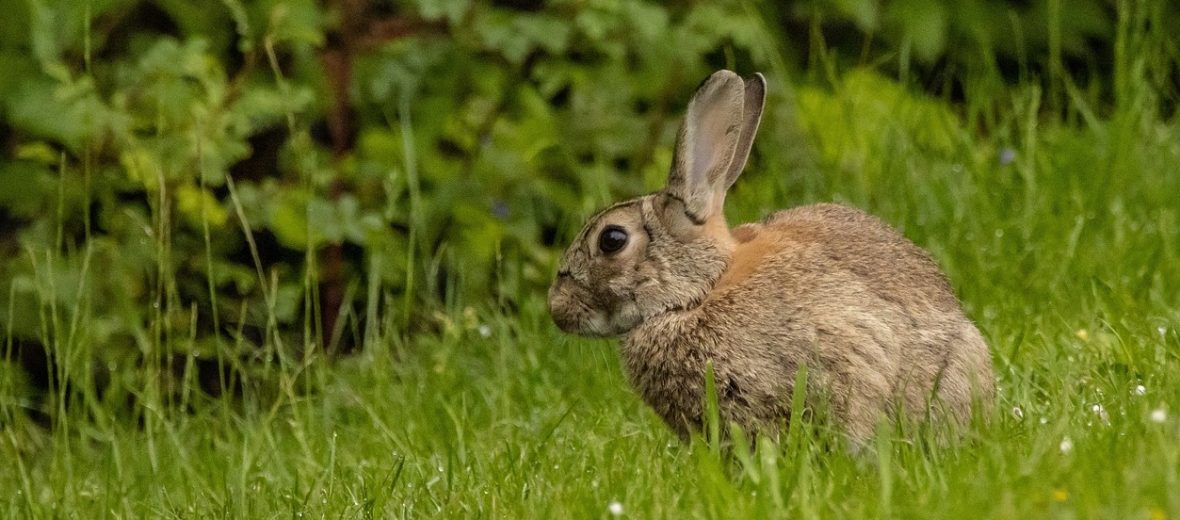
The European rabbit is endemic to Europe. However, they have been introduced to Africa, Australia, Asia, North and South America. These lagomorphs (nope rabbits are not rodents) prefer short grasslands with an ample supply of hiding places, like hedgerows, scrubs, burrows, boulders, and woodlands that border their feeding areas. Even though they have a broad distribution, these critters face the threats of habitat destruction at the hands of farming, ranching, wood pulp plantations, and fire suppression; hunting; trapping; invasive species (and with them disease, competition for food, and predation); pollution; and climate change (that brings about habitat disrupting weather). They are listed as Endangered by the IUCN in their native range. Their numbers are also decreasing.
First the Stats…
Scientific name: Oryctolagus cuniculus
Weight: Up to 5.5 lbs.
Length: Up to 16 inches
Lifespan: Up to 9 years
Now on to the Facts!
1.) These gregarious rabbits dwell in colonies of up to 10 individuals.
2.) Dominance hierarchies are well established within each colony.
3.) Females, aka does, are typically more aggressive than males, aka bucks.
4.) A rabbit burrow is called a warren.
5.) The European rabbit is quite well known for their extensive warrens, which have a large network of tunnels and chambers.
But wait, there’s more on the European rabbit!
6.) Most of their time is spent within their warrens, which makes them fossorial (spend most or all of their time in underground burrows).
7.) European rabbits rarely ever venture farther than 164 feet from their warrens.
Did you know…?
They can hop at speeds of up to 35 mph!
8.) While typically silent, these lagomorphs do have a couple vocalizations they emit. These include the high-pitched squeal or scream, and the shrill grunt.
9.) A wide variety of grasses and young leaves, as well as crops from agricultural lands are all on the menu. During the winter months, these critters will eat bark and blackberries. Like all leporids, they also engage in coprophagia – eating their own feces (poop).
10.) Their mating habits are also interesting. The dominant bucks are polygynous (1 male mates with several females), whereas bucks and does that rank lower in command are monogamous (mate with just 1 partner for at least a season or 2).
But wait, there’s still more on the European rabbit!
11.) Via a substance secreted through a chin gland, others are scent marked when there is intent to breed.
12.) Females undergo up to a 30 day gestation (pregnancy) that yields up to 7 kittens.
Did you know…?
These rabbits might come with a status of Endangered, but they are considered an invasive species on every continent in which they have been introduced.
13.) Just before birth, the doe will build an individual burrow called a stop or stab. This birth burrow is set up to protect the kittens from predators and adult bucks.
14.) Kittens are nursed only 1 time each night and only for a few minutes. Then the doe seals the entrance, each day, to the stop to keep her kittens safe.
15.) The European rabbits have also been widely domesticated. They have been selectively bred to sport a variety of colors and fur types.
But wait, there’s still a little more on the European rabbit!
16.) Even though both the bucks and does dig warrens, does tend to be more skilled at it.
17.) In the winter, European rabbits can live for up to 8 days without food.
18.) The other common name of “coney” or “cony,” referring to their pelt, was introduced before the name rabbit, at around the 13th century. In time cony or coney meant an adult and rabbit meant a juvenile.
19.) During breeding season, adults sleep on the ground while the kittens sleep in the burrows.
20.) Even though these rabbits are herbivores, they have been documented eating snails. It is believed that this is potentially a way to derive extra protein in their diet.
21.) Their primary predators, that vary based on the locale, are dingoes, dogs, foxes, lynx, stoats, weasels, wolverines, and wolves.
Now a Short European Rabbit Video!
Be sure to share & comment below! Also, check out the Critter Science YouTube channel. Videos added regularly!
Want to suggest a critter for me to write about? Let me know here.
Some source material acquired from: Wikipedia & IUCN



